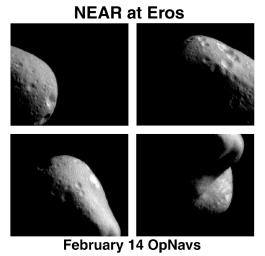
|
Eros: The First Look from Orbit
- Click the image above for a larger view
- Full-Res JPEG (929 x 900) (59.5 kB)
- Full-Res TIFF (929 x 900) (105.5 kB)
Caption:
In the first hours after NEAR's insertion into Eros orbit (February 14, 2000), the spacecraft's camera took these images from a range of 210 miles (330 km) above the surface. The many craters visible serve as landmarks for navigating the spacecraft. Mission operators observe such features from different angles, and use triangulation to calculate NEAR's position relative to the surface of Eros. The changes in position over time help to plot NEAR's course in orbit.
Background Info:
Built and managed by The Johns Hopkins University Applied Physics Laboratory, Laurel, Maryland, NEAR was the first spacecraft launched in NASA's Discovery Program of low-cost, small-scale planetary missions. See the NEAR web page at http://near.jhuapl.edu/ for more details.
Cataloging Keywords:
| Name | Value | Additional Values |
|---|---|---|
| Target | 433 Eros | |
| System | Near Earth Objects | |
| Target Type | Asteroid | |
| Mission | NEAR Shoemaker | |
| Instrument Host | NEAR Shoemaker | |
| Host Type | Orbiter | |
| Instrument | Multi-Spectral Imager (MSI) | |
| Detector | ||
| Extra Keywords | Crater, Grayscale | |
| Acquisition Date | ||
| Release Date | 2000-05-07 | |
| Date in Caption | 2000-02-14 | |
| Image Credit | NASA/JPL/JHUAPL | |
| Source | photojournal.jpl.nasa.gov/catalog/PIA02465 | |
| Identifier | PIA02465 | |
